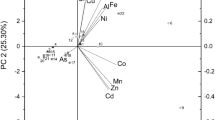Abstract
The aqueous extracts of four marine algae, Caulerpa racemosa var. macrophysa, Gracilaria tenuistipitata var. tenuistipitata, Sargassum sp., and Ulva lactuca, from the coastal areas in Southern Thailand, were prepared by boiling dried seaweed powder in water for 3 h, and by autoclaving each sample at 120 °C for 3 h. They were then freeze-dried and evaluated for their antioxidant activities using DPPH (1, 1-diphenyl-2-picrylhydrazyl), hydroxyl radical (OH•) and superoxide anion (O •−2 ) scavenging assays. Boiling extracts of the seaweeds, except C. racemosa, were found to have higher total phenolic contents (TPC) than those obtained from the autoclave method. The antioxidant results also showed that O •−2 scavenging activity existed only in the boiling extracts of C. racemosa, G. tenuistipitata, and U. lactuca. In DPPH and OH• assays, however, almost all the boiling extracts were less active than the autoclave ones. Among the four alga species, Sargassum sp. was the most active. Both extracts of this seaweed had the highest TPC and also displayed the strongest DPPH• and OH• inhibitory activities. A strong positive-correlation between the antioxidant potency and TPC of the autoclave extracts was found, while for the boiling extracts such relation was very weak. This result thus reflected that in addition to the phenolic compounds, there might be some other active components present in these extracts involved in the antioxidant activity.

Similar content being viewed by others
Abbreviations
- BHT:
-
Butylated hydroxytoluene
- DPPH:
-
1, 1-diphenyl-2-picrylhydrazyl
- NBT:
-
Nitroblue tetrazolium dihydrochloride
- OH• :
-
Hydroxyl radical
- H2O2 :
-
Hydrogen peroxide
- O •−2 :
-
Superoxide anion
- TAE:
-
Tannic acid equivalents
- TPC:
-
Total phenolic content
References
Aruoma OI, Kaur H, Halliwell B (1991) Oxygen free radicals and human diseases. J Roy Soc Promot Health 111:172–177
Ames BN (1983) Dietary carcinogens and anticarcinogens: oxygen radicals and degenerative diseases. Science 221:1256–1264
Stadtman ER (1992) Protein oxidation and aging. Science 257:1220–1224
Wiseman H, Halliwell B (1996) Damage to DNA by reactive oxygen and nitrogen species: role of inflammatory disease and progression to cancer. Biochem J 313:17–29
Larson RA (1995) Plant defenses against oxidative stress. Arch Insect Biochem Physiol 29:175–186
Halliwell B, Aeschbach R, Löliger J, Aruoma OI (1995) The characterization of antioxidants. Food Chem Toxicol 33:601–617
Matsukawa R, Dubinsky Z, Kishimoto E, Masaki K, Matsuda Y, Takeuchi T, Chihara M, Yamamoto Y, Niki E, Karube I (1997) A comparison of screening methods for antioxidant activity in seaweeds. J Appl Phycol 9:29–35
Ramarathnam N, Osawa T, Ochi H, Kawakashi S (1995) The contribution of plant food antioxidants to human health. Trends Food Sci Technol 6:75–82
Kuda T, Tsunekawa M, Goto H, Araki Y (2005) Antioxidant properties of four edible algae harvested in the Noto Peninsula, Japan. J Food Comp Anal 18:625–633
Yuan YV, Walsh NA (2006) Antioxidant and antiproliferative activities of extracts from a variety of edible seaweeds. Food Chem Toxicol 44:1144–1150
Zubia M, Robledo D, Freile-Pelegrin Y (2007) Antioxidant activities in tropical marine macroalgae from the Yucatan Peninsula, Mexico. J Appl Phycol 19:449–458
Iwai K (2008) Antidiabetic and antioxidant effects of polyphenols in brown alga Ecklonia stolonifera in genetically diabetic KK-Ay mice. Plant Foods Hum Nutr 63:163–169
Chew YL, Lim YY, Omar M, Khoo KS (2008) Antioxidant activity of three edible seaweeds from two areas in South East Asia. LWT-Food Sci Technol 41:1067–1072
Hou W-Y, Chen J-C (2005) The immunostimulatory effect of hot-water extract of Gracilaria tenuistipitata on the white shrimp Litopenaeus vannamei and its resistance against Vibrio alginolyticus. Fish & Shellfish Immunol 19:127–138
Huang R, Lee HT (2005) Immunological properties of the marine brown alga, Endarachne binghamiae (Phaeophyceae). Inter J Appl Sci Engr 3:167–173
Velioglu YS, Mazza G, Gao L, Oomah BD (1998) Antioxidant activity and total phenolics in selected fruits, vegetables and grain products. J Agric Food Chem 46:4113–4117
Hutadilok-Towatana N, Chaiyamutti P, Panthong K, Mahabusarakam W, Rukachaisirikul V (2006) Antioxidative and free radical scavenging activities of some plants used in Thai folk medicine. Pharm Biol 44:221–228
Bayer WF, Fridovich I (1987) Assaying for superoxide dismutase activity: some large consequences of minor changes in conditions. Anal Biochem 161:559–566
Matanjun P, Mohamed S, Mustapha NM, Muhamad K, Ming CH (2008) Antioxidant activities and phenolics content of eight species of seaweeds from north Borneo. J Appl Phycol 20:367–373
Targett NM, Arnold TM (1998) Predicting the effects of brown algal phlorotannins on marine herbivores in tropical and temperate oceans. J Phycol 34:195–205
Altena V, Steinberg PD (1992) Are differences in the responses between North American and Australasian marine herbivores to phlorotannins due to differences in phlorotannin structure? Biochem System Ecol 20:493–499
Singh N, Rajini PS (2004) Free radical scavenging activity of an aqueous extract of potato peel. Food Chem 85:611–616
Zhang QB, Li N, Liu XG, Zhao ZQ, Li ZE, Xu ZH (2004) The structure of a sulfated galactan from Porphyra haitanensis and its in vivo antioxidant activity. Carbohydr Res 39:105–111
McDermid KJ, Stuercke B (2003) Nutritional composition of edible Hawaiian seaweeds. J Appl Phycol 15:513–524
Toth G, Pavia H (2000) Lack of phlorotannin induction in the brown seaweed Ascophyllum nodosum in response to increased copper concentrations. Marine Ecol Prog Series 192:119–126
Qi H, Zhang Q, Zhao T, Chen R, Zhang H, Niu X, Li Z (2005) Antioxidant activity of different sulfate content derivatives of polysaccharide extracted from Ulva pertusa (Chlorophyta) in vitro. Inter J Biol Macromol 37:195–199
Wang J, Zhang Q, Zhang Z, Li Z (2008) Antioxidant activity of sulfated polysaccharide fractions extracted from Laminaria japonica. Inter J Biol Macromol 42:127–132
Acknowledgements
This study was funded by Thailand’s Commission on Higher Education. The authors wish to thank Dr. Brian Hodgeson for his helpful suggestions on the manuscript.
Author information
Authors and Affiliations
Corresponding author
Rights and permissions
About this article
Cite this article
Yangthong, M., Hutadilok-Towatana, N. & Phromkunthong, W. Antioxidant Activities of Four Edible Seaweeds from the Southern Coast of Thailand. Plant Foods Hum Nutr 64, 218–223 (2009). https://doi.org/10.1007/s11130-009-0127-y
Published:
Issue Date:
DOI: https://doi.org/10.1007/s11130-009-0127-y




